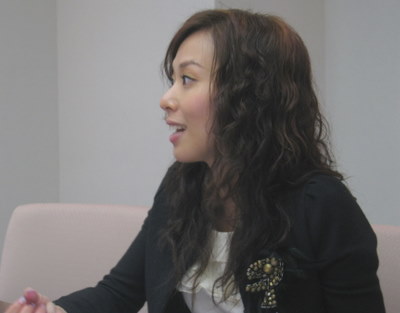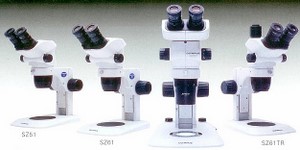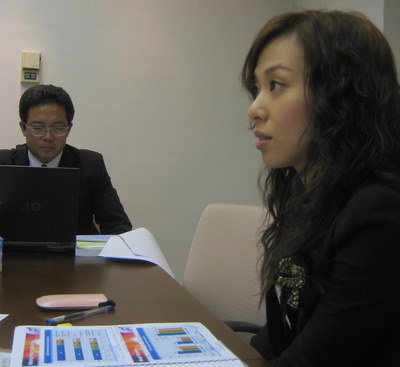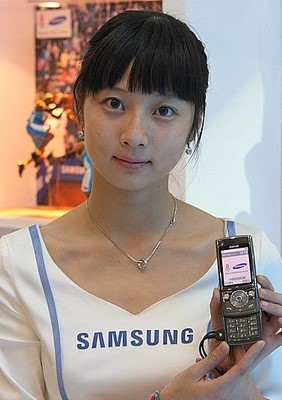
Photo: Andrew Vanburen
SUNNY OPTICAL Technology (Group) Co Ltd (HK: 2382), a producer of optical-related equipment for cell phones, digital cameras, webcams, CCTVs and medical apparatus, supplies Japanese heavyweights Nikon and Olympus with 25% of their lenses, and has recently signed on a new client – Canon.
But in a recent meeting with NextInsight, Aries Consulting and a group of Greater China fund managers, a company executive said that handsets would continue to drive earnings for the Zhejiang-based firm going forward.
Ms. Jasmine Wong, Financial Controller for the Hong Kong-listed firm, said that while the globally-recognized digital camera brands from Japan were a solid part of Sunny Optical’s order book, sales of lens sets for cell phone camera brands like South Korea’s Samsung and LG would be the main revenue earner going forward.
Handsdown Handset Heavyweight

Photo: Company
“Our handset-installed lens sets typically have three plastic and one glass component, so that is how our material costs break down. We also do lenses and flash units for digital cameras as well as being engaged in the microscope business. For ultra-thin handsets, we can get by with fewer plastic components and even all glass in some cases,” said Ms. Wong.
“However, cell phone-based lens sets will be our main breadwinner into the coming years, and currently Samsung and Panasonic are out biggest clients in this sector, with the latter constituting 11% of our revenue.”
But Sunny Optical (www.sunnyoptical.com) was not content to rest on its laurels as the Finns would be come knocking soon to seek component suppliers for one of the most famous brands in the European country.
LG is also a growing client, and Nokia and Sharp will be visiting us in a few months to look at our numbers. We are very hopeful that they too will become clients.”
She said that the company had higher-than-average margins in the sector, but not as high as its chief rival – Logon – which enjoyed up to 48% gross margins.
|
|||||||||||||||||||||||||
“Logon is our biggest competitor for camera lens sets and also for cell phone and webcam use. We can do it more affordably than them as our gross margins are around 30%, so we promote this figure to try and wrestle away Logon’s clients,” she said.
Logon had to charge more because its R&D team was primarily Taiwanese, and these experts demanded higher pay.
“Our technicians are mainly locals,” she said.
Ms. Wong said Sunny Optical also touted its quality and shutter speed capabilities when meeting with prospective clients.
“In the slow speed sector, there are numerous players and competitors. But in the fast speed sector, there is more space and we occupy a top-three position.”
Learning from the Masters

Sunny Optical Financial Controller Ms. Jasmine Wong meeting with fund managers. Photo: Andrew Vanburen
Sunny Optical has its own formidable research and development (R&D) facilities, but the Chinese firm also believes in not going out of the way to reinvent the wheel, whenever necessary.
“Our biggest clients are Japanese and South Korean brands, and it also so happens that many of our leading technology has been taught to us by these countries. This has greatly benefited us, of course,” Ms. Wong said.
And this was critical for a company servicing a sector as dynamic and fickle as the handset market, and all four of Sunny Optical’s plants in Zhejiang Province, Zhongshan (in Guangdong Province), Shanghai, and the city of Tianjin in the north were all onboard with the need to stay on top of things, technologically.
Keeping costs, especially technology-based inputs, to a minimum while staying on top of all the latest trends in the industry was key to maximizing profit margins and offering the best returns to shareholders.
“We recently saw workers’ wages increase to around 10% of our total costs from 6% just a short time ago. But we have still managed to keep overall costs under control to protect our margins,” she said.
“We even hope to boost our gross profit margins by around 1-2 percentage points this year, but admittedly, rising labor costs are a challenge.”

Photo: Company
She said lens set sales to the cell phone sector should grow around 15% this year, while digital camera-related component sales should rise between 10-15%.
“We believe that we do offer our employees a very fair and competitive compensation package," she said, adding that this was critical to keeping key talent from jumping over to the competition.
“We also automate whenever possible, but there are some aspects of our production that are labor intensive and can’t easily be done by a machine.”
Two other areas were increasingly getting the attention of Sunny Optical: public security demand and medical technology.
“China’s continued mantra for ‘harmonious development’ means that officials – especially at the city government level – are willing to spend more on police and monitoring equipment,” Ms. Wong said.
This is sadly even more true in the wake of the spate of a half-dozen deadly knife and hammer attacks on schoolchildren in China over the past few weeks.
“There is an increasing emphasis on CCTV (closed circuit TVs) in public spaces, and this is a huge opportunity for us. Gross margins in this area for us are around 40%.”
However, she said that lens sets for medical equipment is proving to be a very hard nut to crack for a variety of industry-specific reasons.
“This is a very touch market to enter. There are very long and expensive product trial periods to undergo. Therefore, we have no plans to make a big move in this area in the near term.”
|
|||||||||||
Therefore, Sunny would stay close to the cell phone lens set sector, with an eye on more comprehensive supply contracts.
“We don’t accept orders from shanzai (bootleg) developers in China because we want to maintain our integrity. We only take orders from authorized, legitimate manufacturers. Also, we want to move beyond making just lens sets and hope to migrate both upstream and downstream in the cell phone supply market,” Ms. Wong said.
And this was not a bad game plan at all, as China’s cell phone users recently topped 780 mln, which is approximately the combined population of the EU and the US.
Related story: SIM TECH: Roaring ahead on 2H blitz







